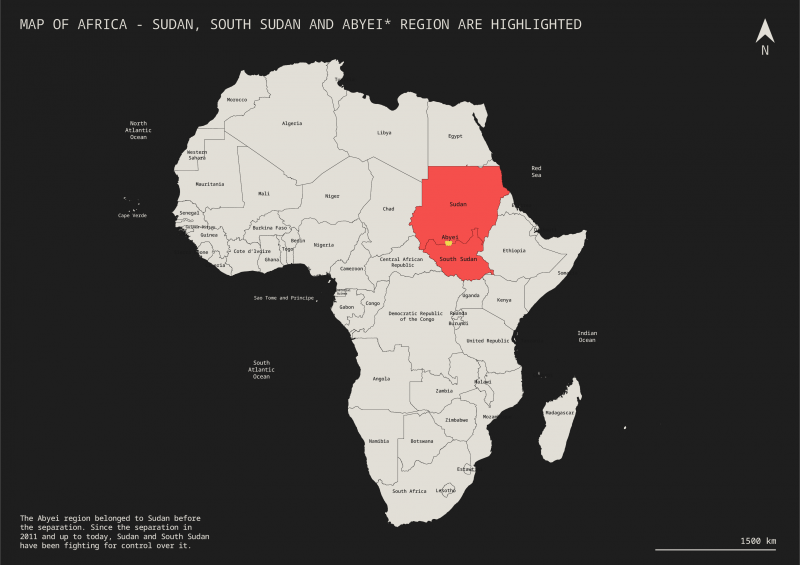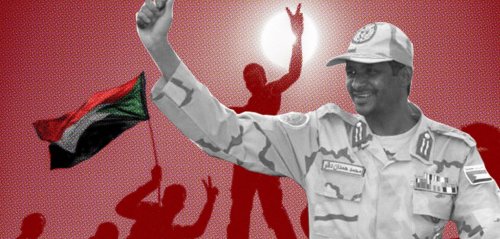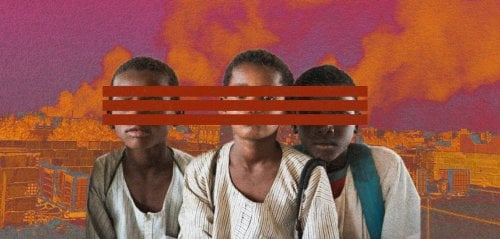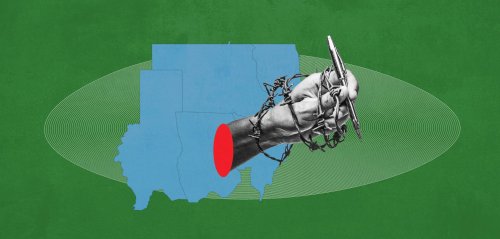The formal separation of Sudan into the north and South went into effect in January 2011, after the South Sudanese referendum. This process was outlined in the Comprehensive Peace Agreement (CPA), where the majority of voters chose secession which was applied on 9 July, 2011. The parties involved in the CPA were the Sudan Armed Forces (SAF) in the North and the Sudan People’s Liberation Movement (SPLM) in the South. The CPA aimed to establish a "sustainable peace" after a decades-long civil war between SAF and SPLM, and the loss of more than 2 million lives.
Nonetheless, the conflict did not cease between the two regions. Following the separation, both Sudan (North) and South Sudan faced internal conflicts as well as tensions with each other. Conflict between the two primarily centered around the imperfectly defined border, which lies in a resource-rich oil region that both sides seek to control.
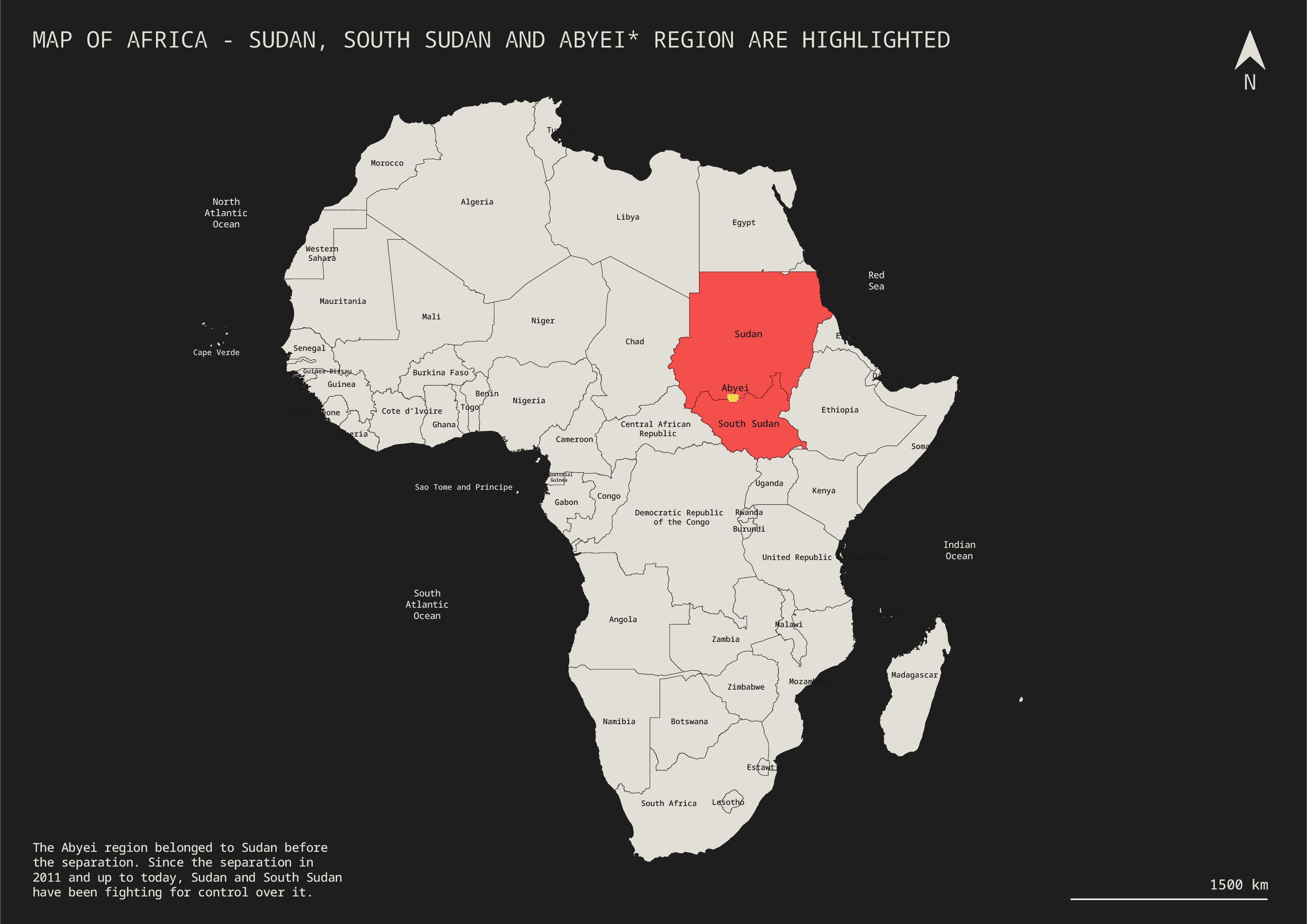 Both Sudan and South-Sudan are marked in red with Abyei, the identified area, in yellow.
Both Sudan and South-Sudan are marked in red with Abyei, the identified area, in yellow.
Both Sudan and South-Sudan are marked in red with Abyei, the identified area, in yellow.
In South Sudan, conflicts arise from the inability of the inexperienced new government to create a political structure and move toward democracy. Other political parties, rather than forming an effective opposition, have resorted to establishing armed forces. Furthermore, competition over natural resources within South Sudan has perpetuated instability and violence.
The situation in the North has been similarly challenging. Despite having relatively better infrastructure, the North has faced ongoing conflicts and power transitions from military to civilian rule. The instability continued until the Arab Spring of 2018, when the government was ousted, creating hope for a better future. However, the situation deteriorated further, culminating in a larger conflict in April 2023.
Both South Sudan and Sudan have experienced foreign involvement in their conflicts. Many countries, such as those in the Gulf, have acted in their own interests and shown little desire to end the violence.
Other nations, like the United States, initially promoted democracy but later shifted focus. For instance, the US encouraged Sudan to sign the Abraham Accords, promising to remove the country from terror lists. Once the accords were signed, international interest in fostering democracy diminished, leaving Sudan in a state of conflict and uncertainty.
These tensions and armed clashes have led to atrocities, civilian harm, and violations of international law. The ongoing fights in these regions have displaced massive numbers of innocent civilians, forcing millions to flee their homes in search of safety within and outside the country.
This visual research focuses on The Republic of Sudan, specifically on armed attacks by various actors in Sudan who pose significant risks to the population, rendering them vulnerable to these attacks. The data provided below was queried from the ACLED platform on November 14, 2024.
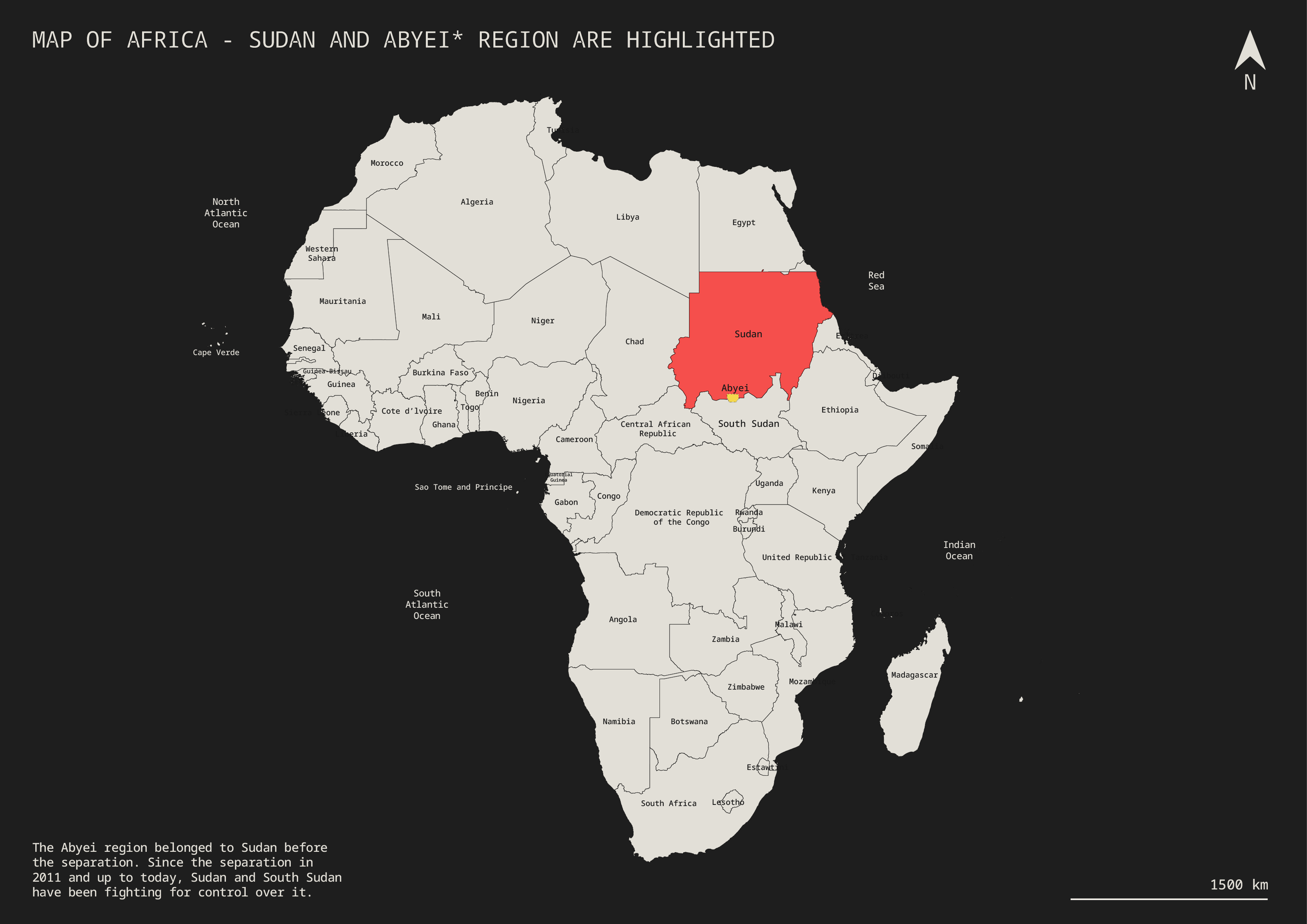 Map of Sudan delineated in red with Abyei, the identified area, shown in yellow.
Map of Sudan delineated in red with Abyei, the identified area, shown in yellow.
Map of Sudan delineated in red with Abyei, the identified area, shown in yellow.
Sudan is in the crossfire of a complicated nest of problems and conflicts, all causing tremendous harm to civilians. These conflicts have led to the deaths of hundreds of thousands and destroyed its already poor infrastructure, causing the fragile economy to further deteriorate.
Ruled by Omar al-Bashir for twenty-nine years, beginning in 1989 after a military coup, the country experienced political instability, violence, and economic crises.
In 2018, protesters took to the streets demanding an increase in the minimum wage due to the ongoing economic crises and inflation. These demands escalated to calls for the fall of al-Bashir’s regime. These demonstrations, which were led by protesters from a range of economic and political backgrounds, formed coalitions to mobilize collective action. Ultimately, al-Bashir’s regime was removed by a military coup led by Abdel Fattah Al-Burhan, one of al-Bashir’s top generals, and leader of the Sudan Armed Forces (SAF), and his deputy General Mohamed Hamdan (known as Hemdti), the leader of the Rapid Support Forces (RSF), which originates from Janjaweed militias. The Janjaweed, which initially served as a militia under al-Bashir, transformed into the RSF during his time in power. The RSF evolved from being mere henchmen to a paramilitary force tasked with protecting al-Bashir from potential coups. However, their leader, Hemdti, conspired with Abdel Fattah Al-Burhan to oust his leader’s regime
In October 2021, after continuous attempts to transition Sudan’s rule to democracy had failed, the military staged another coup, forcing the Prime Minister Abdalla Hamdok to share power with the army. This decision led to widespread protests, which the military responded to with force, resulting in more than 50 deaths according to Sudan’s Central Doctors’ Committee. Following these events, Hamdok resigned in January 2022, leaving the SAF and RSF with total control over the country. A power struggle had already emerged between the SAF and the RSF, which transpired into a full-scale war between the two on April 15, 2023.
Sudan is a large country with a total area of 1,861,484 sq km. Its total population is approximately 50 million. Sudan’s highest population concentrations are found in Khartoum, the capital, and Al Jazirah, according to the December 2024 Humanitarian Data Exchange data set.
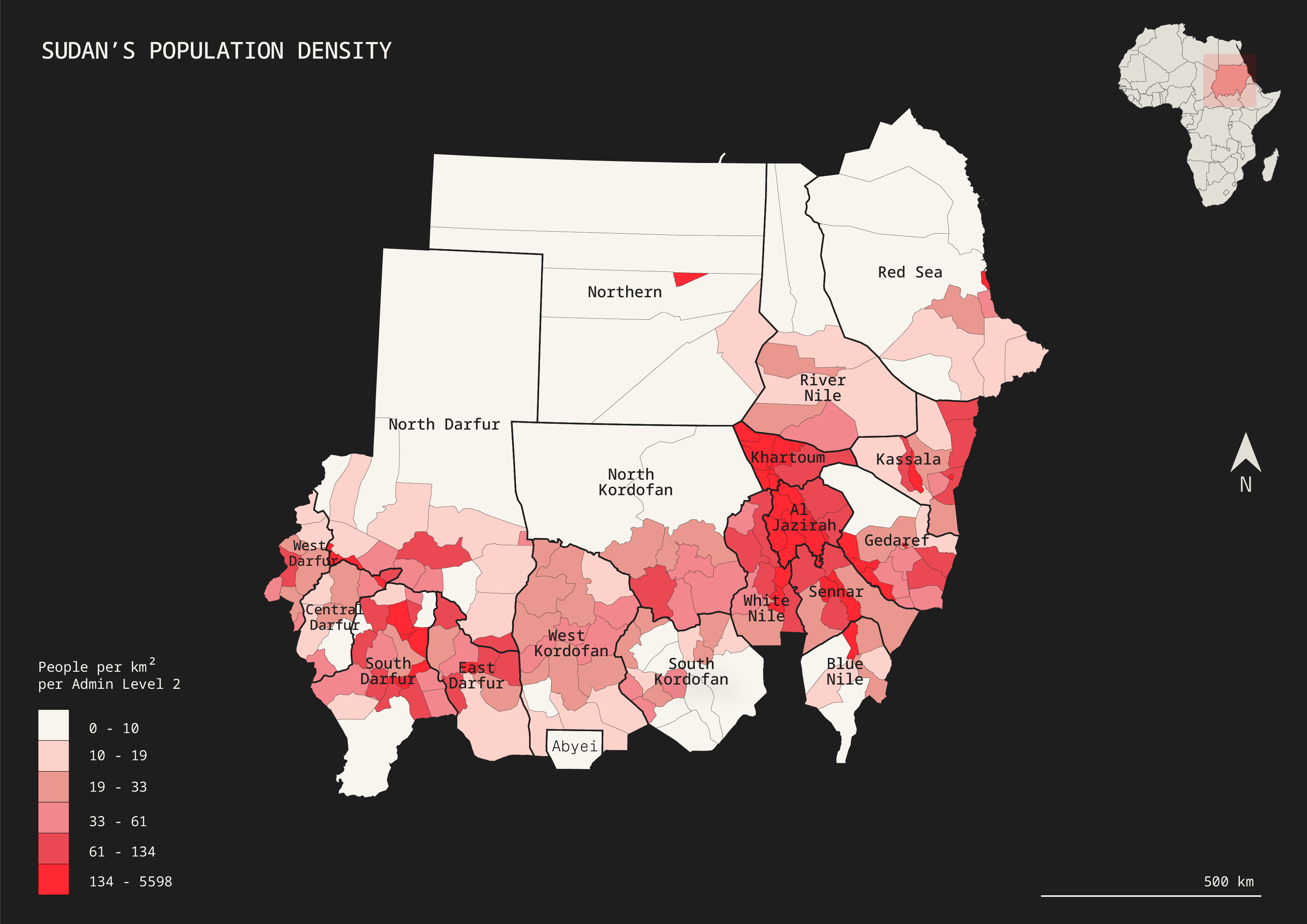 Population density map of Sudan showing people count per 1 km2.
Population density map of Sudan showing people count per 1 km2.
Population density map of Sudan showing people count per 1 km2.
In both Khartoum and Al Jazirah, the population density ranges from 61 to 5,598 persons per square kilometer. Sudan’s ongoing political, economic, and ethnic struggles have resulted in the internal displacement of 4.57 million people who have sought refuge in 4,658 locations across the country, with 69% originating from Khartoum. In addition, approximately 1.1 million individuals fled Sudan to neighboring countries.
Ongoing conflict has led to widespread food insecurity and disease outbreaks, leaving around 15 million people food-insecure. Moreover, the education system has been severely affected, with 12 million children unable to attend classes since April 2023.
This conflict has also led to the involvement of other armed militias and their foreign backers. Many countries are involved in, and influencing, the ongoing conflict, driven by their geopolitical and economic interests. The conflict has left over 25 million people in urgent need of assistance.
Understanding how Sudanese civilians are affected by attacks is crucial for devising effective protective measures and ensuring their safety. The risk and vulnerability map outlined below integrates multiple factors to provide a comprehensive assessment of where individuals are most at risk.
These maps account for hazards through conflict and armed attacks targeting densely populated areas, using Armed Conflict Location & Event Data (known as ACLED) conflict data to identify patterns and hotspots. Second, it evaluates vulnerability across several dimensions, including physical exposure to bombardments, economic strains due to loss of livelihoods and food insecurity, social fragmentation intensified by ethnic cleansing, and health risks ranging from limited access to medical care to psychological trauma.
By reclassifying population densities and correlating them with recorded attacks, this approach highlights specific regions and communities that require urgent interventions to protect civilians, restore stability, and foster resilience against ongoing and future threats.
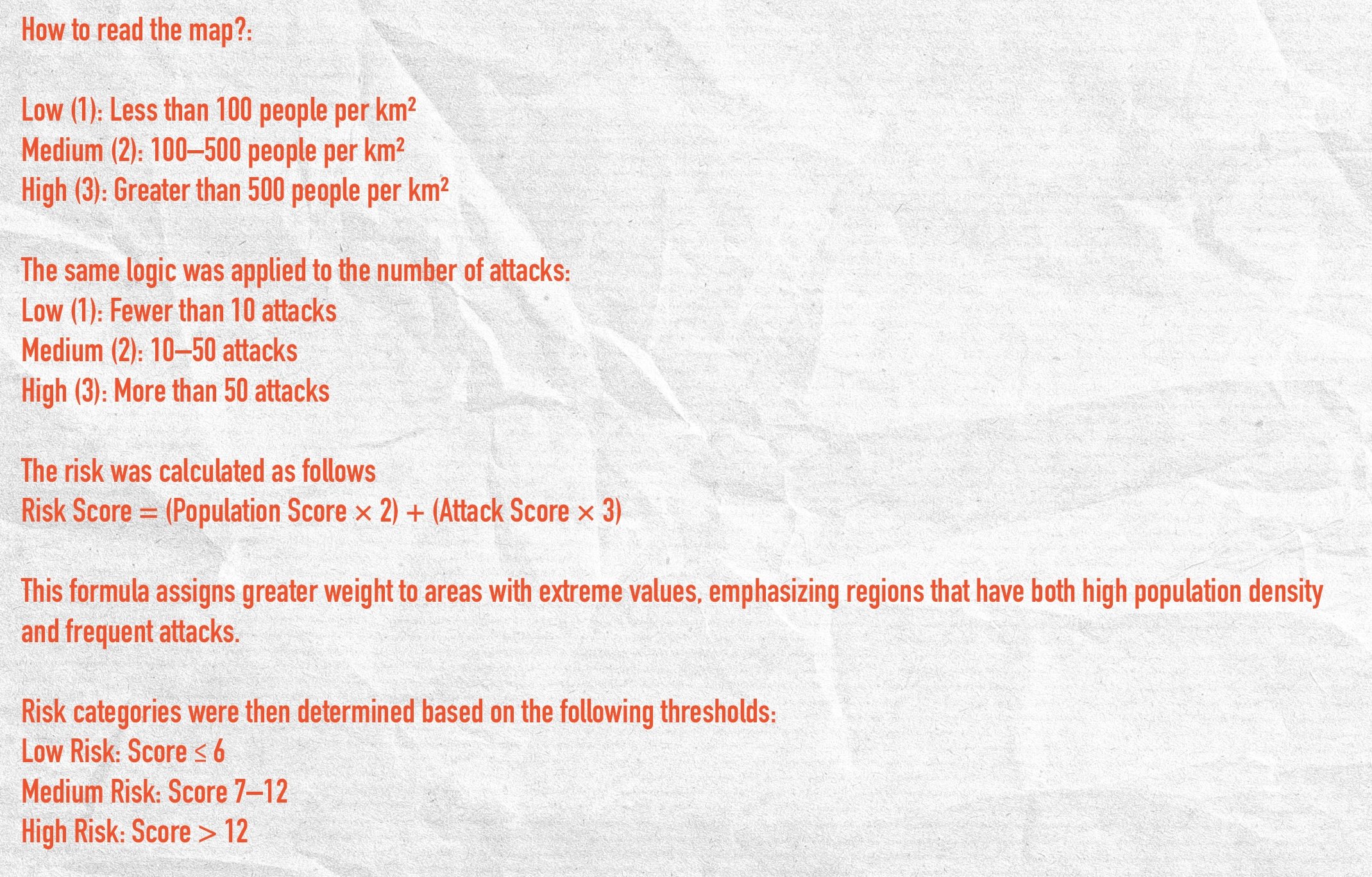 Map legend.
Map legend.
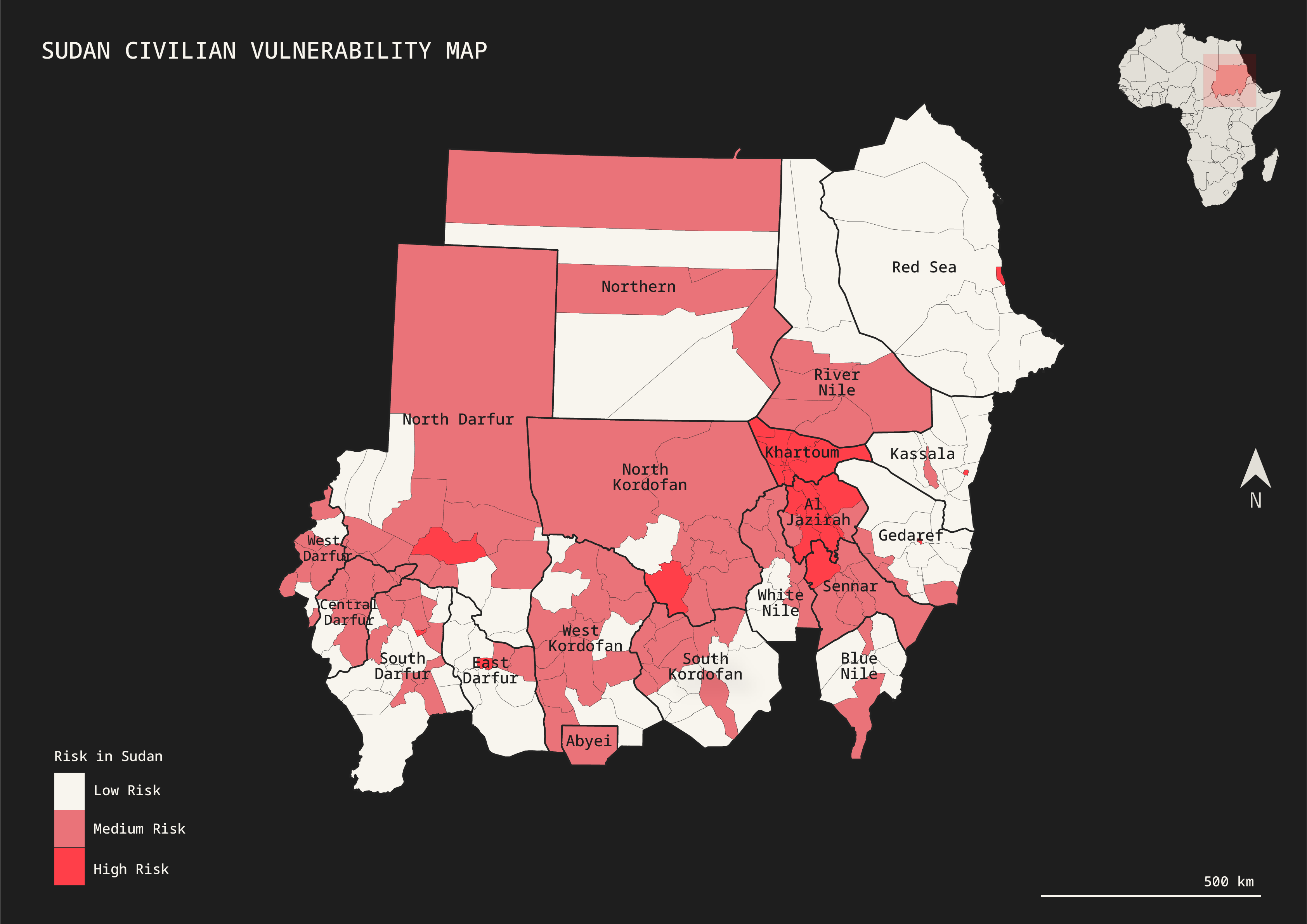 Vulnerability map shows dense areas with large number of attacks to illustrate high risk.
Vulnerability map shows dense areas with large number of attacks to illustrate high risk.
Vulnerability map shows dense areas with large number of attacks to illustrate high risk.
Sudan’s ongoing conflict, which now involves approximately 100 militias from around the world, has resulted in a total of 12,026 recorded attacks by all actors between January 1, 2023, and November 4, 2024, according to ACLED.
Out of 189 cities, only 12 remained unaffected, meaning the majority of cities in Sudan experienced at least one attack between January 1, 2023, and November 14, 2024.
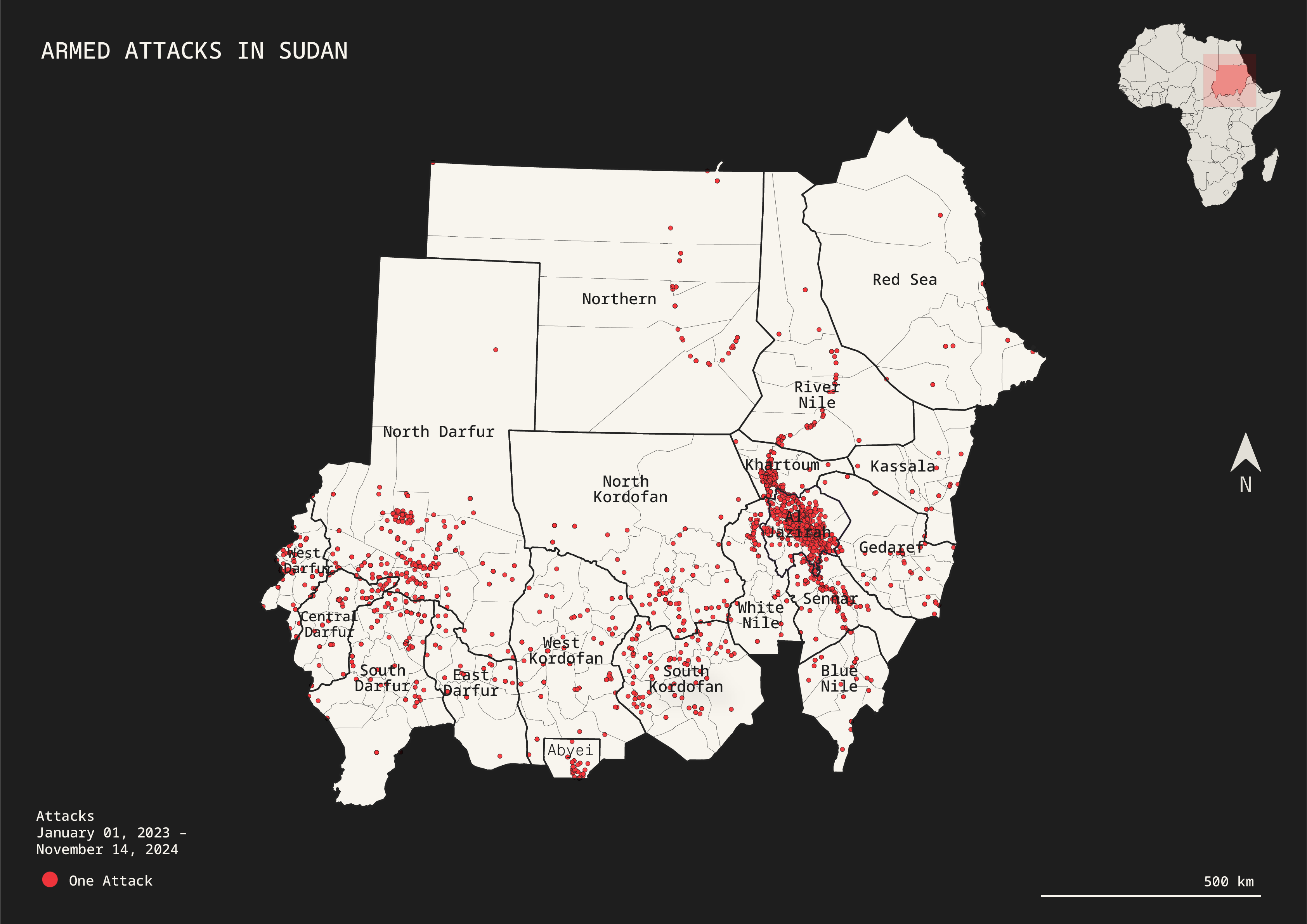 Map shows all armed attacks in Sudan by the conflict's actors.
Map shows all armed attacks in Sudan by the conflict's actors.
Map shows all armed attacks in Sudan by the conflict's actors.
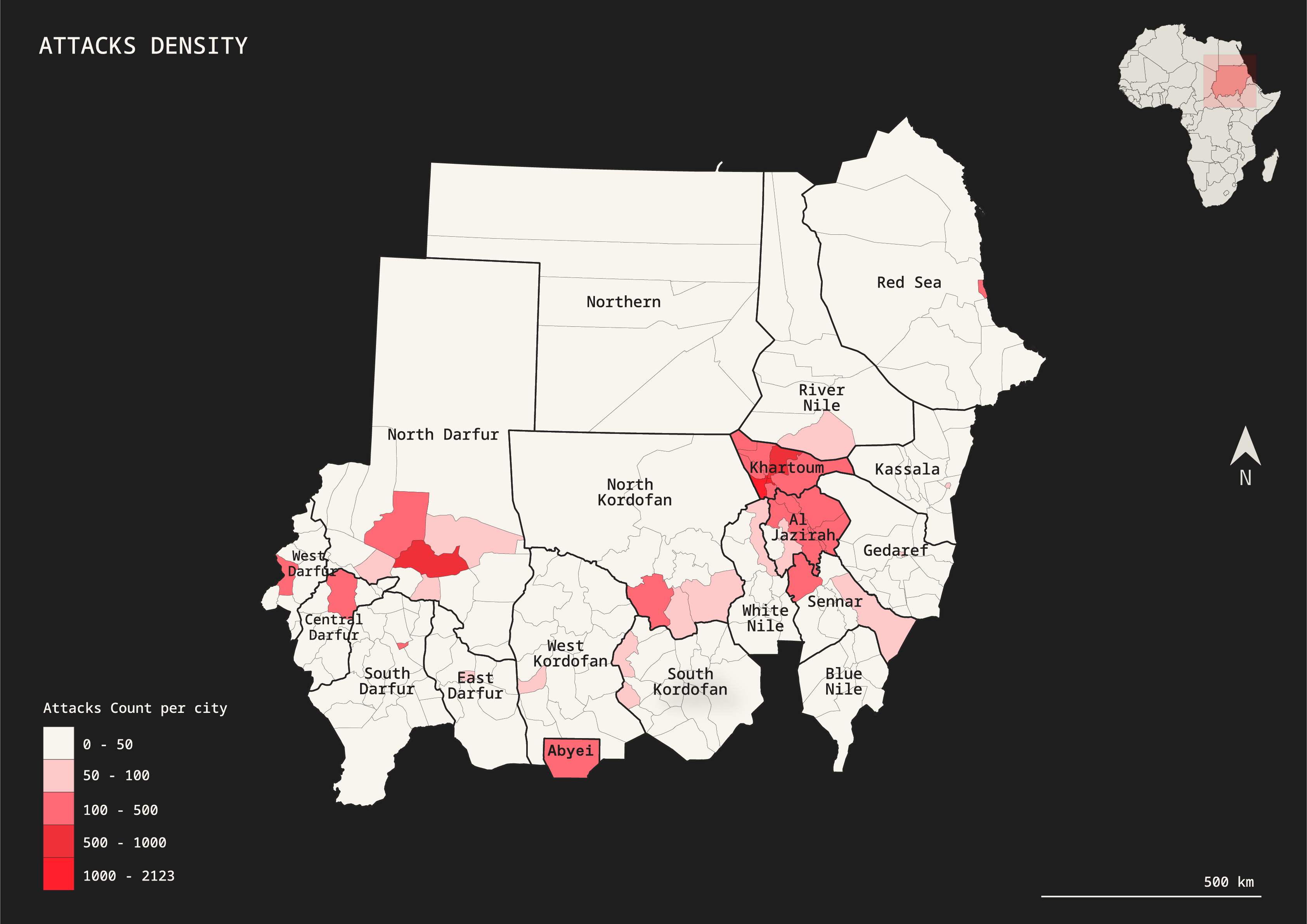 Map illustrates attack density per city.
Map illustrates attack density per city.
Map illustrates attack density per city.
The map separates the attacks by the main actors—the SAF and the RSF—to better illustrate where these incidents are occurring and how many casualties each attack incurs.
Attacks by the SAF are predominantly concentrated in Khartoum and Al Jazirah, with a total of 5,392 recorded incidents between January 01, 2023 and November 14, 2024. The highest number of attacks occurred in Khartoum City within Khartoum County, with 2,123 recorded incidents.
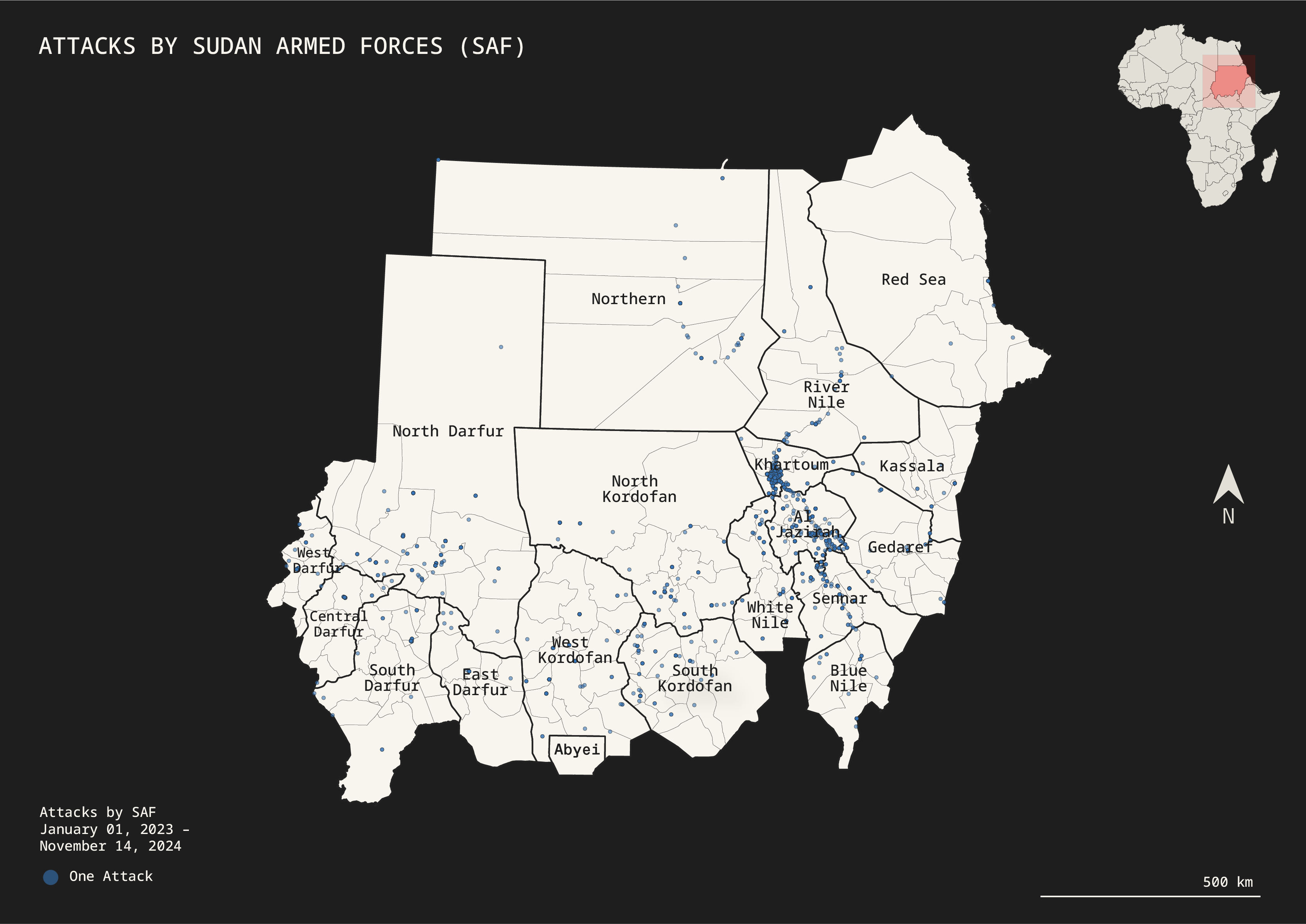 Map shows a count of all SAF attacks.
Map shows a count of all SAF attacks.
Map shows a count of all SAF attacks.
The SAF killed 370 people in a single attack on October 22, 2024, in Sharg Al Jazirah, Al Jazirah. On that day, the SAF gained control of the city, thereby capturing it from the RSF.
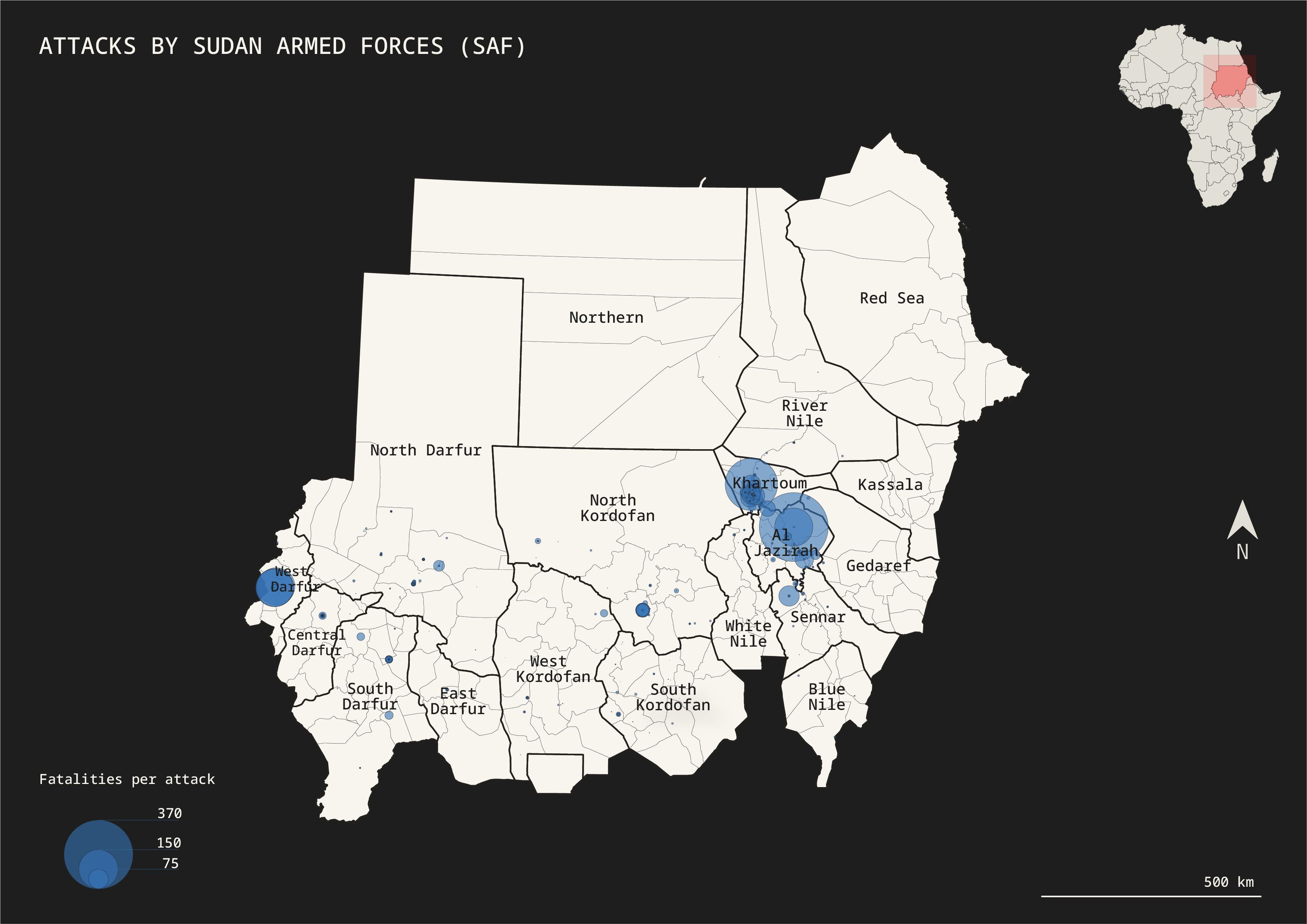 Map illustrates all attacks and size, indicating civilian fatalities, by SAF.
Map illustrates all attacks and size, indicating civilian fatalities, by SAF.
Map illustrates all attacks and size, indicating civilian fatalities, by SAF.
RSF attacks have also been concentrated in Al Jazirah and Khartoum, bringing their total number of assaults to approximately 3,800.
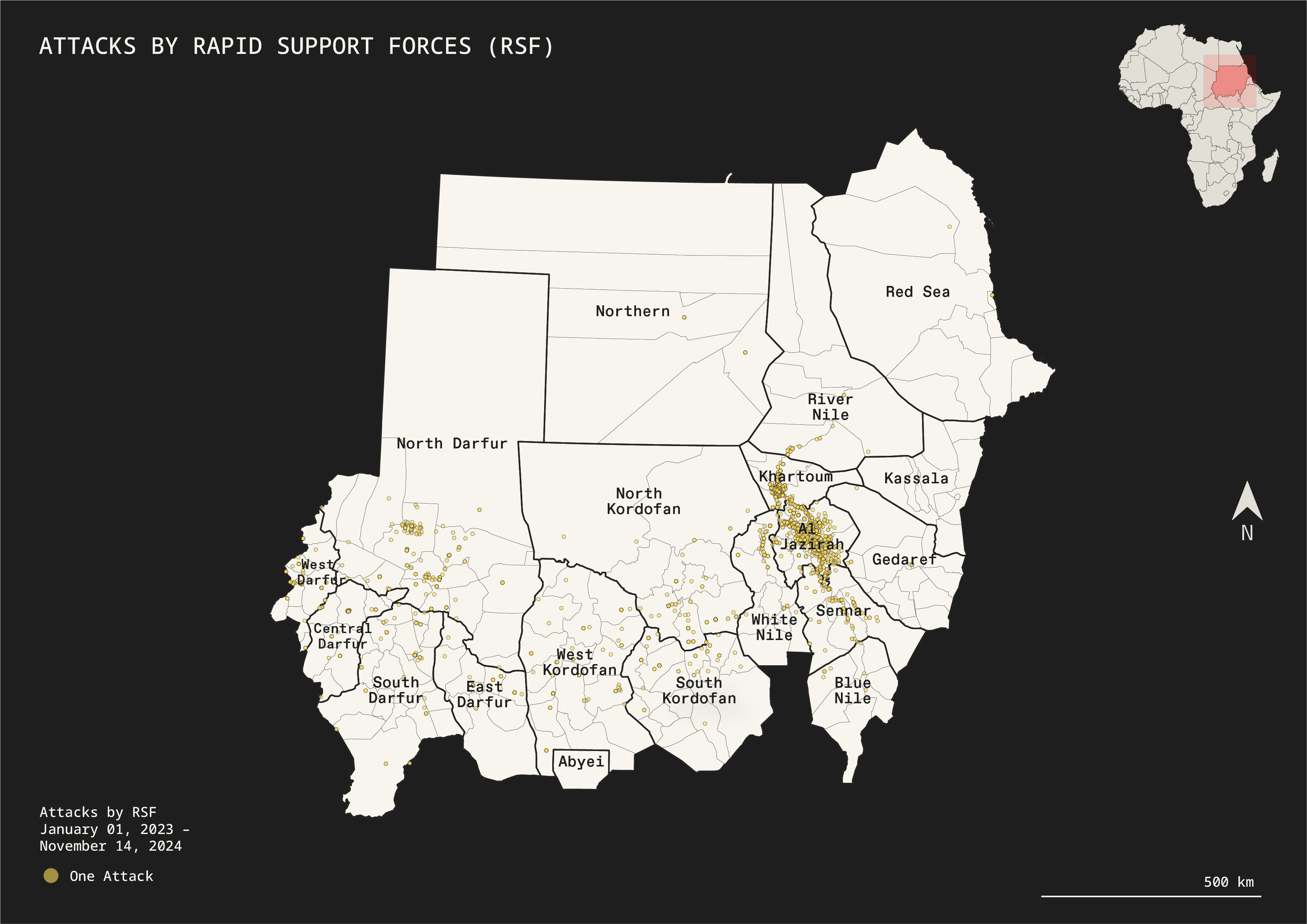 Map shows a count of all RSF attacks.
Map shows a count of all RSF attacks.
Map shows a count of all RSF attacks.
On November 4, 2023, the RSF and Arab RSF-allied militias engaged in clashes with the SAF, which was backed by the Sudanese Alliance Movement. The hostilities resulted in 1,000 deaths in a single day—the highest number of fatalities recorded during that period.
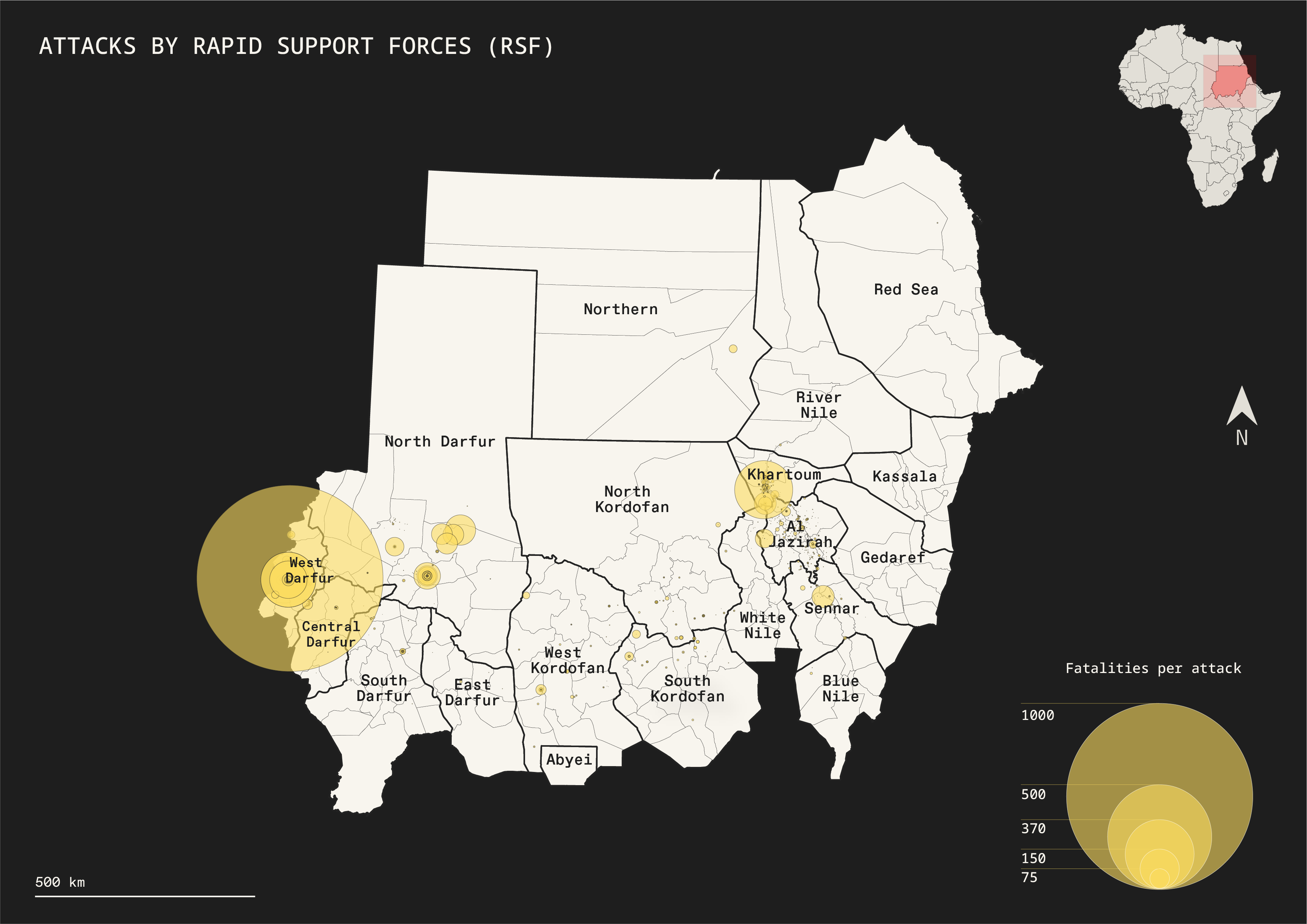 Map illustrates all attacks and size, indicating civilian fatalities, by RSF.
Map illustrates all attacks and size, indicating civilian fatalities, by RSF.
Map illustrates all attacks and size, indicating civilian fatalities, by RSF.
The remaining assaults were carried out by hundreds of other groups, involving more than 100 distinct actors engaged in fighting in Sudan, according to the ACLED dataset on the attacks from January 1, 2023, through November 14, 2024. These include militias from Russia, Ethiopia, South Sudan, Algeria, Eritrea, Chad, Iran, Ukraine, the United Arab Emirates, as well as several other official and unofficial entities.
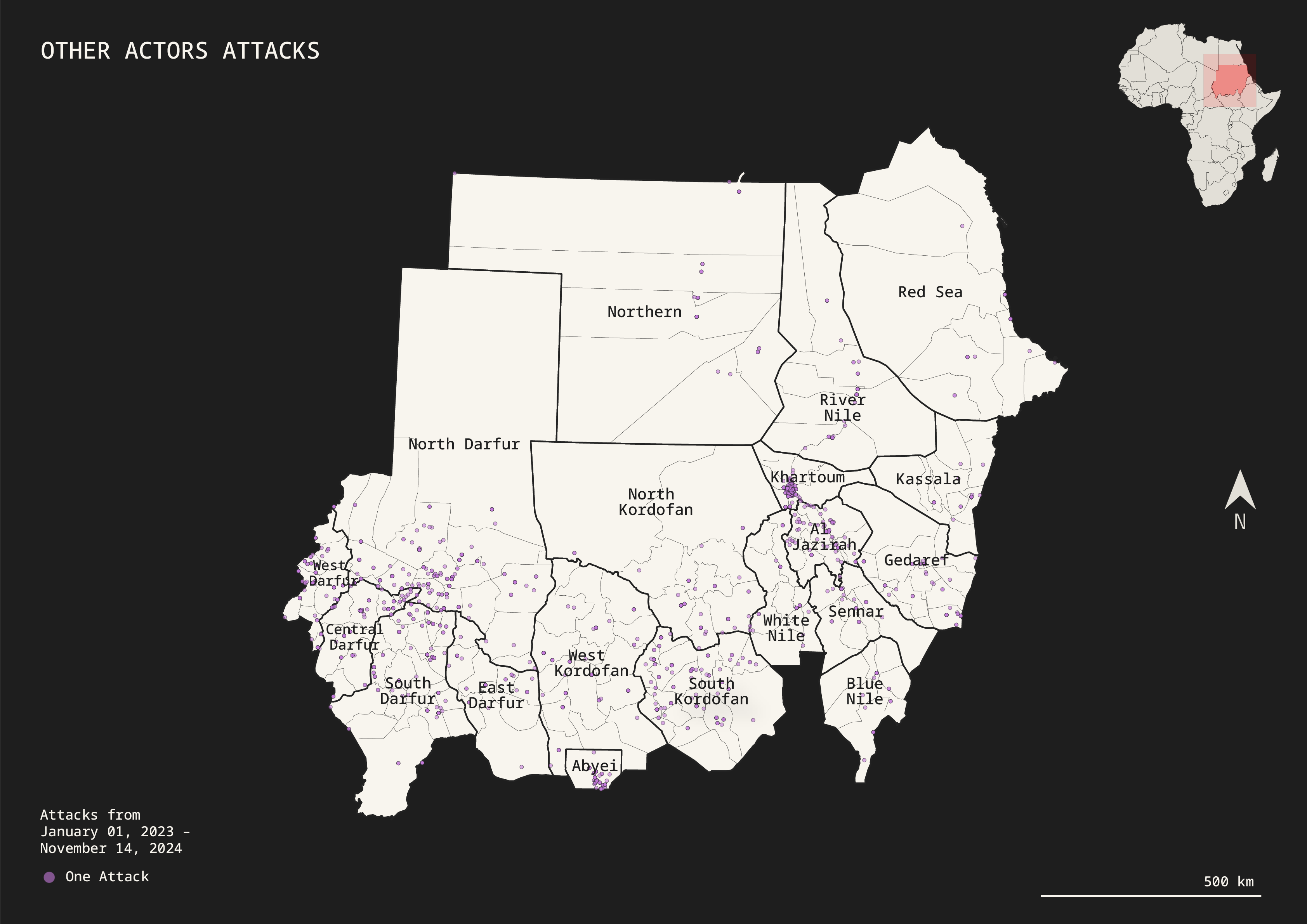 Map shows a count of attacks by other involved actors.
Map shows a count of attacks by other involved actors.
Map shows a count of attacks by other involved actors.
The highest number of fatalities occurred during a clash between the Masalit and the Sudanese Alliance against the RSF, resulting in 79 deaths in a single day on April 24, 2023.
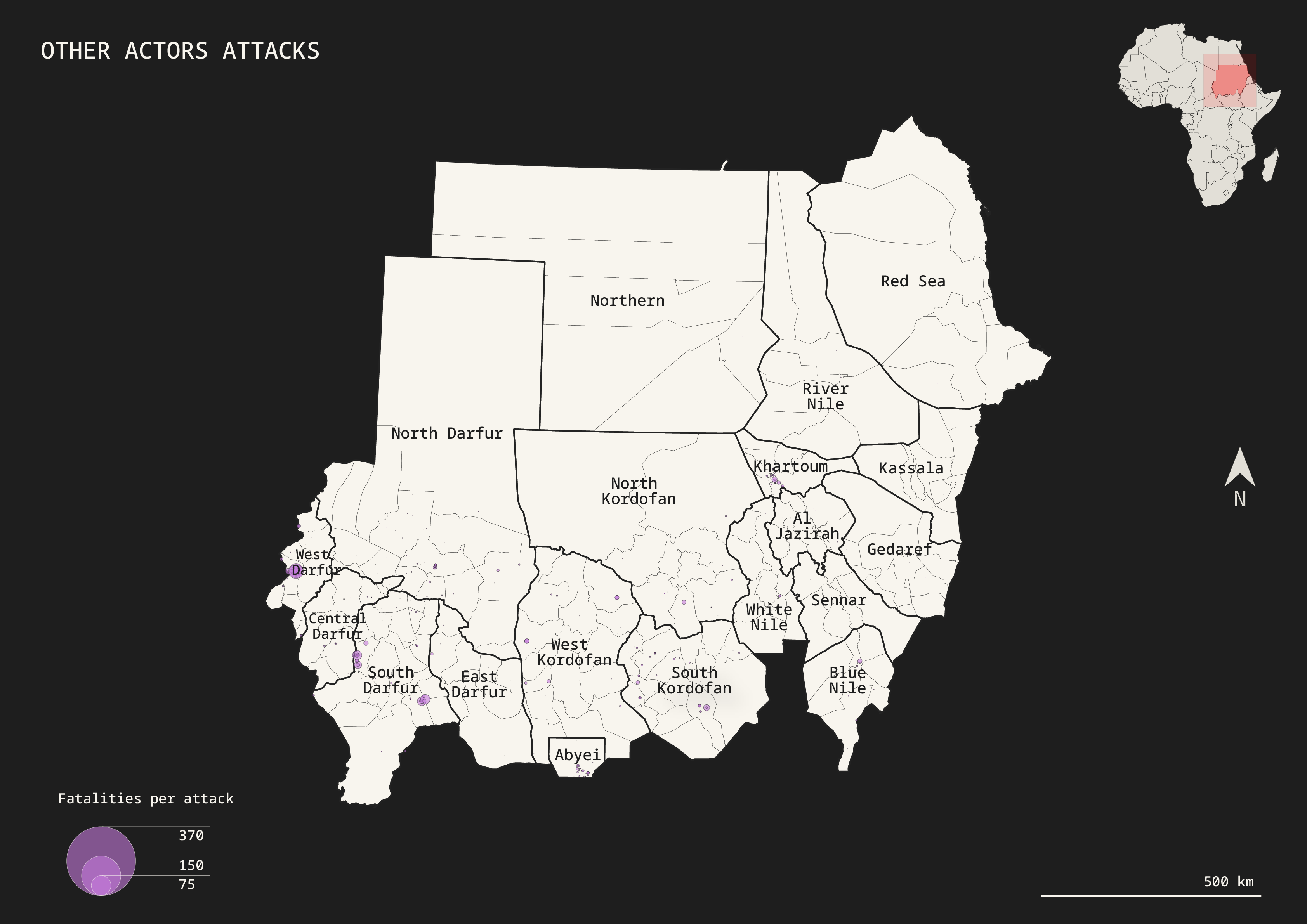 Map illustrates all attacks and size, indicating civilian fatalities, by other involved actors.
Map illustrates all attacks and size, indicating civilian fatalities, by other involved actors.
The spatial analysis above shows that the majority of attacks occur in high-density areas, placing most Sudanese civilians at significant risk. This is particularly evident in Khartoum, which accounts for 54 percent of all recorded incidents (4,858 attacks), rendering it the epicenter of conflict. Other heavily affected areas include Gezira State (12 percent, 1,077 attacks) and North Darfur (9 percent, 818 attacks). The remaining 25 percent of attacks are dispersed across South Darfur, North Kordofan, West Darfur, and other regions. These attacks on civilians have been destroying the infrastructure of the country, weakening the economy, and preventing civilians from leading normal lives.
Potential implications of this analysis for human rights organizations include the urgent need to protect civilians in high-risk areas, with immediate interventions required in places like Khartoum to prevent further harm. Tailored humanitarian aid must be strategically directed to regions most affected, ensuring reliable access to essential resources such as food, water, and healthcare. Simultaneously, thorough documentation of human rights violations and potential war crimes is necessary to hold perpetrators accountable. Advocacy efforts should concentrate on negotiating ceasefires, establishing safe zones, and addressing the underlying causes fueling the conflict.
This data driven story is part of a collaboration with The International Fund for Public Interest Media (IFPIM).
Raseef22 is a not for profit entity. Our focus is on quality journalism. Every contribution to the NasRaseef membership goes directly towards journalism production. We stand independent, not accepting corporate sponsorships, sponsored content or political funding.
Support our mission to keep Raseef22 available to all readers by clicking here!
Interested in writing with us? Check our pitch process here!
